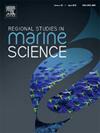Inorganic elements in blood, eggs, and embryos of olive ridley sea turtle (Lepidochelys olivacea) from Sanquianga Natural National Park, Colombia
IF 2.1
4区 环境科学与生态学
Q3 ECOLOGY
引用次数: 0
Abstract
The concentration of eight inorganic elements (As, Cd, Cr, Cu, Hg, Pb, Se and Zn) was analysed for the first time in the blood (adults), eggs, embryos, embryo carapaces, and sand from nests of olive ridley turtles (Lepidochelys olivacea) of the Sanquianga National Natural Park (Colombian Pacific coast). Zinc was the element that showed the highest concentration, followed by Cr and Se. Sand and embryo carapaces were the samples that showed the highest concentrations. Significant correlations were identified between the elements, being most of them reported by first time in this species. Molar ratio Se:Hg was greater than 1 in all the samples, indicating that there is sufficient Se to bind to Hg, and therefore, counteracting its potential toxicity to health. Likewise, five correlations were associated with the carapace of the embryos and none with sand, suggesting maternal transfer contamination. The results obtained provide novel information about exposure to inorganic elements in nesting sea turtles in the eastern tropical Pacific.
求助全文
约1分钟内获得全文
求助全文
来源期刊

Regional Studies in Marine Science
Agricultural and Biological Sciences-Ecology, Evolution, Behavior and Systematics
CiteScore
3.90
自引率
4.80%
发文量
336
审稿时长
69 days
期刊介绍:
REGIONAL STUDIES IN MARINE SCIENCE will publish scientifically sound papers on regional aspects of maritime and marine resources in estuaries, coastal zones, continental shelf, the seas and oceans.
 求助内容:
求助内容: 应助结果提醒方式:
应助结果提醒方式:


